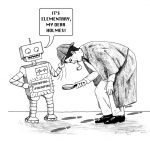The Book of Why
 “Correlation does not imply causation.” This mantra has been invoked by scientists for decades, and has led to a virtual prohibition on causal talk in science. But today, that taboo is dead. The causal revolution, sparked by Judea Pearl and his colleagues, has cut through a century of confusion and established causal inference — the study of cause and effect — as a legitimate subject for scientific inquiry.
“Correlation does not imply causation.” This mantra has been invoked by scientists for decades, and has led to a virtual prohibition on causal talk in science. But today, that taboo is dead. The causal revolution, sparked by Judea Pearl and his colleagues, has cut through a century of confusion and established causal inference — the study of cause and effect — as a legitimate subject for scientific inquiry.
In this book, Pearl and Mackenzie tell the history behind the curious taboo on causality, explain the mathematical principles behind our intuitive conception of cause and effect, and give numerous examples to show that scientists can use those principles to answer questions of pressing interest to society. They explain how causal diagrams arose out of Pearl’s earlier work on artificial intelligence, and why the principles of causal inference are an essential ingredient in realizing the dream of “strong AI” — truly human-like machine intelligence. And they make a strong case that the current fashion for “big data” is missing a vital ingredient. In the absence of causal hypotheses, data alone can never answer questions like, “What caused this sidewalk to be wet?” or “Why did sales go down in this quarter?” or “Will this medicine prevent a heart attack?”
The ability to ask (and answer) “Why?” is the essence of human thought. This book is about empowering scientists and machines with the same ability that is our birthright as human beings. The Book of Why will replace “Of course we can’t answer that question” with “Of course we can!”
I will post excerpts of the upcoming book as they become available. For early visitors to this page, here is a truly special treat: a preview of the book’s introduction in manuscript form. (This selection has not been copy-edited and does not represent the final draft of the book.)
This selection will be deleted when the galley proofs become available.



